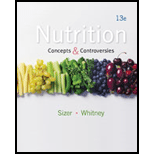
Concept explainers
Concept Introduction:
Monosaccharide is the simplest form of carbohydrate. They cannot be broken down since they consists only a single sugar group. Examples of monosaccharide include fructose (sugar) and glucose (blood sugar). Cells can utilize the glucose found in food directly for energy; meanwhile fructose is converted to glucose in the liver.
Answer to Problem 1RQ
Correct answer:
The correct option is (a) ‘that may help maintain hydration and contribute to blood glucose’.
Explanation of Solution
Option (a) is given ‘that may help maintain hydration and contribute to blood glucose’. During short, intense physical exercise (like wrestling or boxing), monosaccharide is the only fuel having ability of providing the body with energy quickly enough. In the first few minutes of any intense physical activity, it is carbohydrate that almost exclusively meets energy demands. This is the basic unit of carbohydrate. So, it is the correct answer.
Option (b) is ‘also called electrolytes, to help replace those lost during physical activities’. Monosaccharide is broken into fructose and glucose and not electrolyte which help to replace the energy lost during physical activity. Hence, option (b) is incorrect.
Option (c) is ‘that provide a nutrient advantage to most people’. Monosaccharides are non-essential nutrients. It means the body can produce all of those it needs for proper functioning from other nutrients, so monosaccharide do not need to get them from food. Also, they are not advantageous for every individual. Hence, the option (c) is incorrect
Option (d) id given as ‘a and c’. Option (a) is correct but option (c) does not justify an answer with (a). Hence, option (d) is given (a) and (c) is incorrect answer.
Hence, options (b), (c), and (d) are incorrect.
Therefore, monosaccharide in sports drinks helps to maintain hydration and contribute to blood glucose.
Want to see more full solutions like this?
Chapter 10 Solutions
Nutrition: Concepts and Controversies
- Which of the following statements is not true? a. Essential nutrients can be synthesized by the body. b. Vitamins are required in small quantities for bodily function. c. Some amino acids can be synthesized by the body, while others need to be obtained from diet. d. Vitamins come in two categories: fat-soluble and water-soluble.arrow_forwardSome nutritionists claim that the secret to long life is to be slightly underweight as an adult. If a persons weight is related partly to diet, partly to activity level, and partly to genetics, what underlying factors could be at work to generate statistics that support this claim?arrow_forwardEffects of Dietary Fats on Lipoprotein Levels Cholesterol that is made by the liver or that enters the body from food does not dissolve in blood, so it is carried through the bloodstream by lipoproteins. Low-density lipoprotein (LDL) carries cholesterol to body tissues such as artery walls, where it can form deposits associated with cardiovascular disease. Thus, LDL is often called bad cholesterol. Highdensity lipoprotein (HDL) carries cholesterol away from tissues to the liver for disposal, so HDL is often called good cholesterol. In 1990, Ronald Mensink and Martijn Katan published a study that tested the effects of different dietary fats on blood lipoprotein levels. Their results are shown in Figure 2.23. In which group was the level of LDL (bad cholesterol) highest?arrow_forward
 Comprehensive Medical Assisting: Administrative a...NursingISBN:9781305964792Author:Wilburta Q. Lindh, Carol D. Tamparo, Barbara M. Dahl, Julie Morris, Cindy CorreaPublisher:Cengage LearningEssentials of Pharmacology for Health ProfessionsNursingISBN:9781305441620Author:WOODROWPublisher:Cengage
Comprehensive Medical Assisting: Administrative a...NursingISBN:9781305964792Author:Wilburta Q. Lindh, Carol D. Tamparo, Barbara M. Dahl, Julie Morris, Cindy CorreaPublisher:Cengage LearningEssentials of Pharmacology for Health ProfessionsNursingISBN:9781305441620Author:WOODROWPublisher:Cengage





